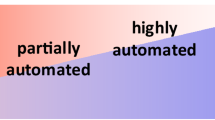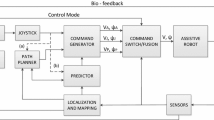Abstract
This paper discusses on the cooperation and the learning processes to increase the autonomy of a human–machine system or an artificial or human agent. The autonomy is defined as the capacity for a system or an agent to fend alone. It is described in terms of competences and the limits of these competences. Cooperation and learning aim then at increasing the competences or managing the system limits. The management of the autonomy is detailed through different structures of cooperation. It concerns the sharing control between systems or between agents in order to recover their limits. Different classes of learning processes are proposed: the mimicry-based approaches, the dysfunction-based ones, and the wait-and-see-based ones. Advanced Driver Assistance Systems (ADAS) are usually designed integrating cooperation characteristics. Two case studies about the use of cooperative ADAS are then proposed. They are hypothetical scenarios that are discussed to introduce possible future ADAS perspective implementing competences such as learning or cooperative learning.








Similar content being viewed by others
References
Aïmeur E (1998) Application and assessment of cognitive dissonance—theory in the learning process. J Univers Comput Sci 4(3):216–247
Bentivegna DC, Atkeson CG, Chenga G (2004) Learning tasks from observation and practice. Rob Auton Syst 47:163–169
Carabelea C, Boissier O (2006) Coordinating agents in organisations using social commitments. Electron Notes Theor Comput Sci 150:73–91
Chella A, Dindo H, Infantino I (2006) A cognitive framework for imitation learning. Rob Auton Syst 54:403–408
Chignell M, Hancock P (1985) Knowledge-based load levelling and task allocation in human–machine systems. In: Proceeding of annual conference on manual control, vol 21, pp 9.1–9.11
Chu H-C, Chen T-Y, Lin C-J, Liao M-J, Chen Y-M (2009) Development of an adaptive learning case recommendation approach for problem-based e-learning on mathematics teaching for students with mild disabilities. Expert Syst Appl 36:5456–5468
Conway CM, Christiansen MH (2001) Sequential learning in non-human primates. Trends Cogn Sci 5(12):539–546
De Waard D (1996) The measurement of drivers’ mental workload. PhD thesis, University of Groningen. Haren, The Netherlands: University of Groningen, Traffic Research Centre
Demazeau Y (1995) From interactions to collective behaviour in agent-based systems. In: Proceedings of the 1st European conference on cognitive science, Saint-Malo, France, pp 117–132
Inagaki T (2010) Traffic systems as joint cognitive systems: issues to be solved for realizing human-technology co-agency. Cogn Technol Work 12:153–162
Jouglet D, Piechowiak S, Vanderhaegen F (2003) A shared workspace to support man-machine reasoning: application to cooperative distant diagnosis. Cogn Technol Work 5:127–139
Millot P, Hoc J-M (1997) Human–machine cooperation: metaphore or possible reality? In: Proceedings of the 2nd European conference on cognitive science, Manchester, UK, April 9–11, pp 165–174
Ouedraogo A, Enjalbert S, Vanderhaegen F (2010) How to learn from the Resilience of human–machine systems? In: Proceedings of the 11th IFAC/IFIP/IFORS/IEA symposium on analysis, design and evaluation of human–machine systems, Valenciennes, France, August–September 2010
Parmentier FBR, Muaybery MT, Huitson M, Jones DM (2008) The perceptual determinants of repetition learning in auditory space. J Mem Lang 58:978–997
Polet P, Vanderhaegen F, Millot P (2009) Human behaviour analysis of barrier deviation using the benefit-cost-deficit model. In: Advances in human–computer interaction. Available on http://www.hindawi.com/journals/ahci/2009/642929/
Rajaonah B, Tricot N, Anceaux F, Millot P (2008) Role of intervening variables in driver-ACC cooperation. Int J Hum Comput Stud 66:185–197
Schulte A, Meitinger C, Onken R (2009) Human factors in the guidance of uninhabited vehicles: oxymoron or tautology? The potential of cognitive and co-operative automation. Cogn Technol Work 11:71–86
Seery MD (2011) Challenge or threat? Cardiovascular indexes of resilience and vulnerability to potential stress in humans. Neurosci Biobehav Rev 35:1603–1610
Sheridan TB (2000) Function allocation algorithm, alchemy or apostasy. Int J Human Mach Stud 52:203–216
Tošić PT, Vilalta R (2010) A unified framework for reinforcement learning, co-learning and meta-learning how to coordinate in collaborative multi-agent systems. Procedia Comput Sci 1:2217–2226
Tricot N, Rajaonah B, Popieul J-C, Millot P (2006) Design and evaluation of an advanced driver assistance system: the case of an auto adaptive cruise control. Trav Hum 69:129–152
Vanderhaegen F (1997) Multilevel organization design: the case of the air traffic control. Control Eng Pract 5(3):391–399
Vanderhaegen F (1999a) Cooperative system organisation and task allocation: illustration of task allocation in air traffic control. Trav Hum 63(3):197–222
Vanderhaegen F (1999b) Multilevel allocation modes—allocator control policies to share tasks between human and computer. Syst Analy Modelling Simul 35:191–213
Vanderhaegen F (1999c) Toward a model of unreliability to study error prevention supports. Interact Comput 11:575–595
Vanderhaegen F (2010a) Human-error-based design of barriers and analysis of their uses. Cogn Technol Work 12:133–142
Vanderhaegen F (2010b) Autonomy control of human–machine systems. In: Proceedings of the 11th IFAC/IFIP/IFORS/IEA symposium on analysis, design and evaluation of human–machine systems, Valenciennes, France, August–September 2010
Vanderhaegen F, Jouglet D, Piechowiak S (2004) Human-reliability analysis of diagnosis support cooperative redundancy. IEEE Trans Reliab 53(4):458–464
Vanderhaegen F, Chalmé S, Anceaux F, Millot P (2006) Principles of cooperation and competition—application to car driver behavior analysis. Cogn Technol Work 8(3):183–192
Vanderhaegen F, Zieba S, Polet P (2009) A reinforced iterative formalism to learn from human errors and uncertainty. Eng Appl Artif Intell 22:654–659
Vanderhaegen F, Zieba S, Enjalbert S, Polet P (2011) A Benefit/Cost/Deficit (BCD) model for learning from human errors. Reliab Eng Syst Safety 96(7):757–776
Xiabo Z, Ohno K (2000) Properties of a sequencing problem for a mixed model assembly line with conveyor stoppage. Eur J Oper Res 124:560–570
Young HP (2009) Learning by trial and error. Games Econ Behav 65(2):626–643
Zhang Z, Polet P, Vanderhaegen F, Millot P (2004) Artificial neural network for violation analysis. Reliab Eng Syst Safety 84(1):3–18
Zieba S, Polet P, Vanderhaegen F, Debernard S (2009) Resilience of a human–robot system using adjustable autonomy and human–robot collaborative control. Int J Adapt Innov Syst 1(1):13–29
Zieba S, Polet P, Vanderhaegen F, Debernard S (2010) Principles of adjustable autonomy: a framework for resilient human machine cooperation. Cogn Technol Work 12(3):193–203
Zieba S, Polet P, Vanderhaegen F (2011) Using adjustable autonomy and human–machine cooperation to make a human–machine system resilient—application to a ground robotic system. Inform Sci 181(3):379–397
Acknowledgments
The present research work has been supported by the International Campus on Safety and Intermodality in Transportation the European Community, the Délégation Régionale à la Recherche et à la Technologie, the Ministère de l’Enseignement Supérieur et de la Recherche, the Région Nord Pas de Calais and the Centre National de la Recherche Scientifique, the Scientific Research Group on Supervisory, Safety and Security of Complex Systems, the European Research Group on Human–Machine Systems in Transportation and Industry: the authors gratefully acknowledge the support of these institutions.
Author information
Authors and Affiliations
Corresponding author
Rights and permissions
About this article
Cite this article
Vanderhaegen, F. Cooperation and learning to increase the autonomy of ADAS. Cogn Tech Work 14, 61–69 (2012). https://doi.org/10.1007/s10111-011-0196-1
Received:
Accepted:
Published:
Issue Date:
DOI: https://doi.org/10.1007/s10111-011-0196-1




